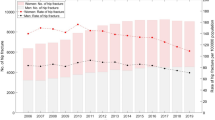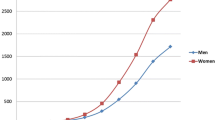Abstract
Summary
We analyzed hip fracture incidence trends in Germany 1995-2004, using national hospital discharge register. Crude incidences per 100,000 increased from 121.2 (95% CI 120.5-121.9) in 1995 to 140.9 (140.2-141.7) in 2004. Age-sex-adjusted annual incidence ratios showed a statistically significant, but only slight increase (1.01, p < 0.01), compared to higher rises in the past. Trends differed markedly with sex, age, and regions.
Introduction
Data concerning actual trends of the hip fracture incidence and differences for sex, age, and region are limited. We analyzed hip fracture incidence trends in Germany 1995-2004, using the national hospital discharge register. Crude incidences per 100,000 increased from 121.2 (95% CI 120.5-121.9) in 1995 to 140.9 (140.2-141.7) in 2004. Age-sex-adjusted annual incidence ratios showed a statistically significant, but only slight increase (1.01, p < 0.01), compared to higher rises in the past. Trends differed markedly with sex, age, and regions.
Methods
Analysis of annual hip fracture incidences using the national hospital discharge register. Estimate of age-sex-adjusted changes was found by using Poisson regression (incidence rate ratios, IRR).
Results
The number of patients with at least one hospital admission for hip fracture increased (1995: n = 99,141; 2004: n = 116,281). Crude incidences per 100,000 were 121.2 (95% confidence interval 120.5-121,9) and 140.9 (140.2-141.7), respectively. The age-sex-adjusted hip fracture incidence increased statistically significantly, but only slightly (IRR per year: 1.01; 1.00-1.01; IRR 1995-2004: 1.05, p < 0.01). In men aged 40 years or older, incidences increased. In women, there was a tendency of a decrease up to 74 years of age, but also a significant increase in higher age groups. In people 0-39 years, the incidence declined markedly (IRR 1995-2004, men 0.74; 0.69-0.79, women 0.62; 0.55-0.69, both p < 0.01). The increase was significantly higher in Eastern compared to Western Germany (interaction: p = 0.002), and differences between East and West decreased.
Conclusions
In contrast to earlier years, the hip fracture incidence in Germany 1995-2004 increased only slightly, with a decline in younger people, but increases in older ages, particularly in men. Regional differences decreased.

Similar content being viewed by others
References
Cummings SR, Melton LJ (2002) Epidemiology and outcomes of osteoporotic fractures. Lancet 359:1761–1767
Keene GS, Parker MJ, Pryor GA (1993) Mortality and morbidity after hip fractures. BMJ 307:1248–1250
Kannus P, Pakkari J, Niemi S (1995) Age-adjusted incidence of hip fractures. Lancet 346:350–351
Wildner M, Clark DE (2001) Hip fracture incidence in East and West Germany. Reassessment 10 years after unification. Osteoporos Int 12:136–139
Finsen V, Johnsen LG, Trano G, Hansen B, Sorensen Sneve K (2004) Hip fracture incidence in central Norway: A follow up study. Clin Orthop 419:173–178
Giversen IM (2006) Time trends of age-adjusted incidence rates of first hip fractures: a register-based study among older people in Viborg County, Denmark, 1987–1997. Osteoporos Int 17:552–564
Lönnroos E, Kautiainen H, Karppi P, Huusko T, Hartikainen S, Kiviranta I, Sulkava R (2006) Increased incidence of hip fractures. A population based study in Finland. Bone 39:623–627
Bjorgul K, Reikeras O (2007) Incidence of hip fracture in southeastern Norway. Int Orthop 31:665–669
Jaglal SB, Weller I, Mamdani M, Hawker G, Kreder H, Jakkimainen L, Adachi JD (2005) Population trends in BMD testing, treatment, and hip and wrist fracture rates: are the hip fracture projections wrong? J Bone Miner Res 20:898–905
Hernandez JL, Olmos JM, Alonso MA, Gonzales-Fernandez CR, Martinez J, Pajaron M, Llorca J, Gonzales-Macias J (2006) Trend in hip fracture epidemiology over a 14-year period in a Spanish population. Osteoporos Int 17:464–470
Gehlbach SH, Avrunin JS, Puleo E (2006) Trends in hospital care for hip fracture. Osteopor Int 18:585–591
Kannus P, Niemi S, Parkkari J, Palvanan M, Vuori I, Jarvinen M (2006) Nationwide decline in incidence of hip fracture. Bone Mineral Res 21:1836–1838
Löfmann O, Berglund K, Larsson L, Toss G (2002) Changes in hip fracture epidemiology: Redistribution between ages, genders, and fracture types. Osteopor Int 13:18–25
Centers for Disease Control and Prevention (2006) Fatalities and injuries from falls among older adults-United States, 1993–2003 and 2001–2005. MMWR Morb Mortal Wkly Rep 55:1221–1224
Chevalley T, Guilley E, Herrmann FR, Hoffmeyer P, Rapin CH, Rizzoli R (2007) Incidence of hip fracture over a 10-year period (1991-2000): Reversal of a secular trend. Bone 40:1284–1289
Hoffmann F, Glaeske G (2006) Incidence of proximale femure fracture in Germany. Individual-based analysis of a statutory health insurance‘ population. Gesundheitswesen 68:161–164
Le CT (2003) Introductory biostatistics. Wiley, Weinheim
Nymark T, Lauritsen JM, Ovesen O, Rock ND, Jeune B (2006) Decreasing incidence of hip fracture in the Funen County, Denmark. Acta Ortop 77:109–113
Lesic A, Jarebinski M, Pekmezovic T, Bumbasirevic M, Spasovski D, Atkinson HDE (2007) Epidemiology of hip fractures in Belgrade, Serbia Montenegro, 1990-2000. Arch Orthop Trauma Surg 127:179–183
Johnell O, Gullberg B, Allander E, Kanis A, and the MEDOS Study Group (1992) The apparent incidence of hip fracture in Europe: A study of national register sources. Osteoporos Int 2:298–302
Icks A, Haastert B, Meyer G (2007) Remarkable decline in hip fracture incidence in younger age groups in Germany. Am J Publ Health 97:1733–1734
LÖGD (Institute for the Public Health Service). Available at: http://www.loegd.nrw.de. Accessed March 10, 2007
Centers for Disease Control and Prevention (CDC) (2006) National trends in injury hospitalizations, 1979-2001. National Hospital Discharge Survey. Available at: http://www.cdc.gov. Accessed March 23, 2007
Robert-Koch Institute (ed) (2006) National Health Report for Germany. RKI, Berlin
Schwabe U, Paffrath D (eds) (2005) Drug prescription report, Germany 2005. Springer Heidelberg New York
Becker C, Kron M, Lindemann U, Sturm E, Eichner B, Walter-Jung B, Nikolaus T (2003) Effectiveness of a multifaceted intervention on falls in nursing home residents. J Am Geriatr Soc 51:306–313
Meyer G, Warnke A, Bender R, Mühlhauser I (2003) Effect on hip fractures of increased use of hip protectors in nursing homes: cluster-randomised controlled trial. BMJ 326:76–78
Samelson EJ, Zhang Y, Kiel DP, Hannan MT, Felson DT (2002) Effect of birth cohort on risk of hip fracture: Age-specific incidence rates in the Framingham Study. Am J Publ Health 92:858–862
Acknowledgement
The study was supported by a grant from the North-Rhine Westphalian Ministry of Health and Social Services. We would like the Health Counselling Committee of the North-Rhine Westphalian Chamber of Physicians (Head Dr. Arnold Schüller) for their support. We would further like to thank Dr. Olaf Schoffer, Research Department of the National Statistical Office, for his support in data management, and Prof. Florian Gebhard, Clinic of Surgery, University of Ulm, for his support in interpreting the results.
Funding
The study was supported by a grant from the North-Rhine Westphalian Ministry of Health and Social Services.
Conflict of interest statement
All authors declare that they have no conflict of interest.
Author information
Authors and Affiliations
Corresponding author
Rights and permissions
About this article
Cite this article
Icks, A., Haastert, B., Wildner, M. et al. Trend of hip fracture incidence in Germany 1995–2004: a population-based study. Osteoporos Int 19, 1139–1145 (2008). https://doi.org/10.1007/s00198-007-0534-6
Received:
Accepted:
Published:
Issue Date:
DOI: https://doi.org/10.1007/s00198-007-0534-6




